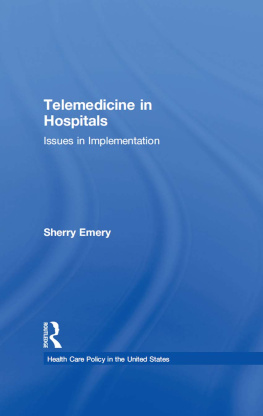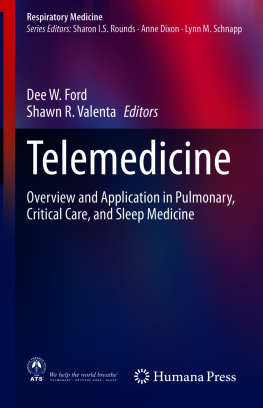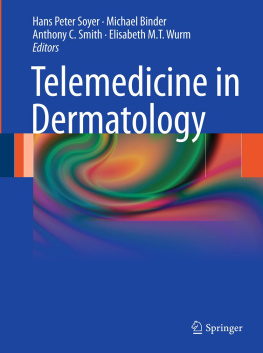HEALTH CARE POLICY IN THE UNITED STATES
edited by
JOHN G. BRUHN
PENNSYLVANIA STATE
UNIVERSITY-HARRISBURG
Health Care Policy in the United States
John G. Bruhn, editor
Physician Participation in Medicaid Managed Care
Sunday E. Ubokudom
Healing the Social Body: A Holistic Approach to Public Health Policy
Elizabeth R. Mackenzie
Directing Health Messages toward African Americans: Attitudes toward Health Care and the Mass Media
Judith L. Sylvester
Gender Justice and the Health Care System
Karen L. Baird
Who Cares for Poor People? Physicians, Medicaid, and Marginality
Margaret M. Hynes
Health Care Reform: Policy Innovations at the State Level in the United States
Larry E. Carter
Telemedicine in Hospitals: Issues in Implementation
Sherry Emery
TELEMEDICINE IN HOSPITALS
ISSUES IN IMPLEMENTATION
SHERRY EMERY
First published 1998 by Garland Publishing, Inc.
This edition published 2015 by Routledge
711 Third Avenue, New York, NY 10017, USA
2 Park Square, Milton Park, Abingdon, Oxon, OX14 4RN
Routledge is an imprint of the Taylor & Francis Group, an informa business
Copyright 1998 Sherry Emery
All rights reserved
Library of Congress Cataloging-in-Publication Data
Emery, Sherry.
Telemedicine in hospitals : issues in implementation / Sherry Emery.
p. cm. (Health care policy in the United States)
Includes bibliographical references and index.
ISBN 0-8153-3223-8 (alk. paper)
1. Rural health servicesUnited StatesCommunication systemsPlanning. 2. HospitalsUnited StatesCommunication systemsPlanning. 3. Telecommunication in medicineUnited StatesPlanning. I. Title. II. Series: Health care policy in the United States (New York, N.Y.)
RA771.5.E45 1998
362.1028dc21
98-29436
ISBN 13 : 978-0-8153-3223-7 (hbk)
Contents
I would like to acknowledge and thank the US Office of Rural Health Policy, Health Resources and Services Administration, Public Health Service, US Department of Health and Human Services, for funding this research, which was supported by Grant # CSR000002-03-0. This work benefited tremendously from the input of the many interview subjects. Without their candor and insight, the results of this study would lack meaning and depth. To each of the individuals who took the time to speak with me about this research, I am very grateful. I would like to acknowledge the Cecil G. Sheps Center for Health Services Research for the institutional support to conduct this research, and Tom Rickets for his guidance at every stage of this project. I also thank Linda Garcia, Ken Temkin, and Elizabeth McClelland for their friendship and intellectual support. Most importantly, I thank my parents and husband, Marc Garfinkel, for their confidence and unwavering emotional support. Finally, I alone am responsible for any errors or omissions contained in this document.
AHA | American Hospital Association |
ANOVA | Analysis of Variance |
ARF | Area Resource Files |
CODEC | Coder-Decoder |
COTH | Council of Teaching Hospitals |
CT | Computerized Tomography |
ECU | East Carolina University |
GPA | Group Purchasing Alliance |
GSAMS | Georgia State Academic and Medical System |
HCFA | Health Care Finance Administration |
HMO | Health Maintenance Organization |
IDN | Integrated Delivery Network |
IO | Investor Owned |
MHS | Multi hospital system |
MRI | Magnetic Resonance Image |
MSA | Metropolitan Statistical Area |
NFP | Not-for-profit |
NIST | National Institute for Standards and Technology |
NTIA | National Telecommunications and Information Administration |
OMB | Office of Management and Budget |
ORHP | Office of Rural Health Policy |
OTA | Office of Technology Assessment |
RUS | Rural Utilities Service |
SMSA | Standard Metropolitan Statistical Area |
UNC | University of North Carolina |
UNC-CH | University of North Carolina-Chapel Hill |
f | function of |
summation |
/ | divided by |
L | log-odds |
probability |
In | natural log |
Telemedicine in Hospitals
telemedicine \tel-I-med-.-s.n\ n: technologies that allow for medical consultation between health care providers in geographically separate locations, ranging from telephone consultations to interactive video sessions using state-of-the-art technologies.
In 1968, Dr. Kenneth D. Bird solved a problem for Massachusetts General Hospital. The hospital had been responsible for staffing the medical station at Bostons Logan International Airport. Emergencies demanded an immediate, highly skilled response even though the expertise of a physician was rarely required. Therefore, during most of the staffed time at the medical station, the physicians time and labor were underutilizeda significant expense to the hospital and airport. In response to this problem, Dr. Bird developed a system for remote transmission of voice and images. Using this system, doctors working remotely from Massachusetts General Hospital performed physical examinations, made diagnoses, and even delivered limited treatments to ailing travelers using the airports medical station (New York Times, February 16, 1991).
Dr. Bird was not the first innovator of telemedicine, but in the 1960s and early 1970s, his project was among the few that used microwave television technologies to transmit medical images and educational materials. For rural areas, these new telemedicine technologies promised to change how health care and medical education were accessed and delivered. Some of the pioneering telemedicine projects were very successful in achieving such promises. Yet, in its early applications, telemedicine failed to diffuse widely or to change health care dramatically. Now, more than 25 years later, the original telemedicine innovations are being transformed by advances in medical and telecommunications technologies. Once again, telemedicine holds promise as a partial solution to the health care crisis in many urban centers and rural areas of the United States.















